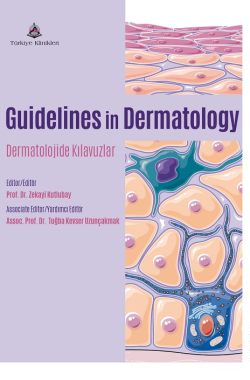KELOID AND HYPERTROPHIC SCARS
Zafer Türkoğlu1
İrem Doğan2
1University of Health Sciences, Başakşehir Çam and Sakura City Hospital, Department of Dermatology and Venereology, İstanbul, Türkiye
2University of Health Sciences, Başakşehir Çam and Sakura City Hospital, Department of Dermatology and Venereology, İstanbul, Türkiye
Türkoğlu Z, Doğan İ. Keloid and Hypertrophic Scars. In: Kutlubay Z, editor. Guidelines in Dermatology. 1st ed. Ankara: Türkiye Klinikleri; 2025. p.267-273.
ABSTRACT
Keloids and hypertrophic scars (HS) are fibroproliferative disorders caused by an uncontrolled wound healing process with excessive deposition of connective tissue and extracellular matrix. Any type of injury, including burns, surgeries, trauma, vaccinations, piercings and infections, can disrupt the physiologic healing process in susceptible individuals, leading to keloids and HSs. Hemostasis, inflammation, proliferation and remodeling are the four stages of the physiological wound healing process. Any disruption in the physiologic wound healing process can lead to scar formation, but most often this occurs during the final stage, remodeling. Excessive extracellular matrix deposition as a result of STAT3 overexpression, hyperactivation of the TGF-b1-SMAD-MAPK pathway, which occurs during the wound healing phase as a result of a dermal injury is thought to be effective in the pathogenesis. It is thought that the inflammatory process may be triggered through many pathologic pathways that have not yet been proven. Generally, keloids are defined as scars due to persistent inflammation, while HSs are defined as scars that gradually lose this dermal inflammation. This diversity in the inflammation process explains the growth patterns of keloids and HS. Hypertrophic scars are pruritic, whereas keloid lesions may have additional pain. Keloid typically tends to extend beyond the wound margin, whereas HS tends to form inside the wound margin. Despite their high prevalence, keloid and HS are still considered challenging dermatologic conditions, as there is no single definitive and effective treatment. However, they have a significant psychological impact on the patient and significantly affect their quality of life. All patients should be examined both physically and psychologically to decide on appropriate treatment modalities. Surgical manipulation is one of the most effective treatment modalities
in the treatment of hypertrophic scarring, whereas surgical manipulations in the treatment of keloids should be avoided as they may aggregate scar formation. Therefore, clinical differentiation is essential. Due to its direct impact on quality of life and cosmetic concerns of the patients, many clinical trials are currently being conducted on more effective treatment modalities. In this chapter, we aim to describe the pathogenesis of HS and keloid, epidemiology, risk factors, clinical features and predisposing factors, histopathology, traditional treatment options and promising new clinical trials.
Keywords: Cicatrix; Cicatrix hypertrophic; Fibrosis; Keloid; Wound healing
Kaynak Göster
Referanslar
- Ogawa R, Dohi T, Tosa M, Aoki M, Akaishi S. The latest Strategy for Keloidand Hypertrophic Scar prevention and Treatment: The Nippon Medical School(NMS) protocol. J Nippon Med Sch. 2021;88(1):2-9. [Crossref] [PubMed]
- Ogawa R. Keloid and hypertrophic scars are the result of chronic inflammation in the reticular dermis. Int J Mol Sci. 2017;18(3):606. [Crossref] [PubMed] [PMC]
- Robles D T, Berg D. Abnormal wound healing: keloids. Clin Dermatol. 2007;25(1):26-32. [Crossref] [PubMed]
- Chike-obi Cj, Cole pd, Brissett AE. Keloids: pathogenesis, clinical features, and management. Semin plast Surg. 2009;23(3):178-84. / [Crossref] [PubMed] [PMC]
- Park TH, Chang CH. Keloid recurrence in pregnancy. Aesthetic Plast Surg. 2012 Oct;36(5): 1271-2. [Crossref] [PubMed]
- Arima J, Huang C, Rosner B, Akaishi S, ogawa R. Hypertension: a systemic key to understanding local keloid severity. Wound Repair Regen. 2015;23(2):213-21. / [Crossref] [PubMed]
- Schmieder Sj, Ferrer-Bruker Sj. Hypertrophic Scarring. 2023 Sep 4. in: Statpearls [internet]. Treasure island (Fl): Statpearls publishing; 2024 / [PubMed]
- Ogawa R. The Most Current Algorithms for the Treatment and Prevention of Hypertrophic Scars and Keloids: A 2020 Update of the Algorithms Published 10 Years Ago. Plast Reconstr Surg. 2022 Jan 1;149(1):79e-94e. [Crossref] [PubMed] [PMC]
- Van de Kar AL, Houge G, Shaw AC, et al. Keloids in Rubinstein-Taybi syndrome: A clinical study. Br J Dermatol. 2014;171:615- 621. [Crossref] [PubMed]
- Kumar S, Chaaudhary S, Paul P, Verma Yk. Exploring STAT3 stimulatory potential of novel wound healing molecules by virtual screening and molecular dynamics simulations. j Biomol Struct dyn. 2023 ;41(17): 8292-306. [Crossref] [PubMed]
- Gauglitz GG, Korting HC, pavicic T, Ruzicka T, jeschke Mg. Hypertrophic scarring and keloids: pathomechanisms and current and emerging treatment strategies. Mol Med. 2011;17(1-2):113-25. [Crossref] [PubMed] [PMC]
- Bleasdale B, Finnegan S, Murray K, Kelly S, percival Sl. The Use of Silicone Adhesives for Scar Reduction. Adv Wound Care (New Rochelle). 2015;4(7):422-30. [Crossref] [PubMed] [PMC]
- Shah VV, Aldahan AS, Mlacker S, Alsaidan M, Samarkandy S, Nouri K. 5Fluorouracil in the Treatment of Keloids and Hypertrophic Scars: A Comprehensive Review of the literature. dermatol Ther (Heidelb). 2016;6(2):169-83. [Crossref] [PubMed] [PMC]
- Nanda S, Reddy BS. Intralesional 5-fluorouracil as a treatment modality of keloids. Dermatol Surg. 2004;30(1):54-57. [Crossref] [PubMed]
- Devereaux J, Nurgali K, Kiatos d, Sakkal S, Apostolopoulos v. Effects of platelet-rich plasma and platelet-poor plasma on human dermal fibroblasts. Maturitas. 2018;117:34-44. [Crossref] [PubMed]
- Betarbet U, Blalock TW. Keloids: A Review of Etiology, prevention, and Treatment. J Clin Aesthet Dermatol. 2020;13(2):33-43. [PMC]
- Ferguson MWJ et al. Avotermin for scar improvement following scar revision surgery: a randomized, double-blind, within-patient, placebo-controlled, phase ii clinical trial. plast Reconstr Surg. 2011;128(1):163-72. [Crossref] [PubMed]
- Bi M, Sun P, Li D, Dong Z, Chen Z. Intralesional injection of Botulinum Toxin Type A Compared with Intralesional Injection of Corticosteroid for the Treatment of Hypertrophic Scar and Keloid: A Systematic Review and Meta-Analysis. Med Sci Monit. 2019;25:2950-8. [Crossref] [PubMed] [PMC]
- Chen H, Hou K, Wu Y, Liu Z. Use of Adipose Stem Cells Against Hypertrophic Scarring or Keloid. Front Cell dev Biol. 2022;9:823694. [Crossref] [PubMed] [PMC]
- Tan M, Wu d, Zhou y, Duan B. Centella triterpenes cream as a potentialdrug for the treatment of hypertrophic scar through inhibiting the phosphorylation of STAT3: A network pharmacology analysis and in vitro experiments. J Cosmet dermatol. 2023;22(12):3511-9. [Crossref] [PubMed]

